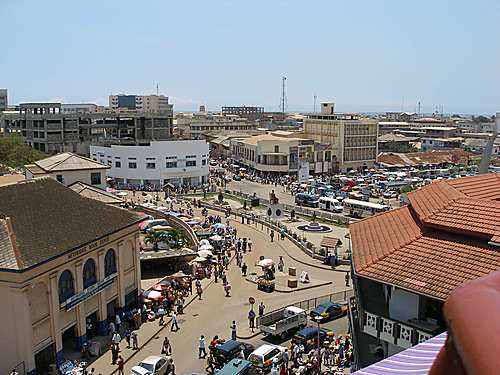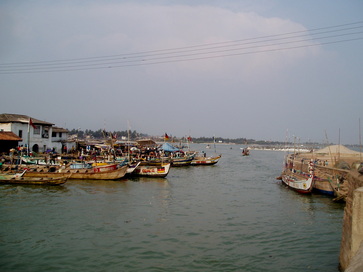PeopleGhana has a population of close to 25 million people from more than 100 different ethnic groups. The major ethnic group, making up almost half the population, is Akan. Most of the Ghanaian people are Christian, with 15% following Islam. A sizable 15% of the population continues to hold African beliefs handed down to them from their forefathers through several centuries.
|
The Republic of Ghana is on the western coast of Africa, with the Ivory Coast to the West and the Gulf of Guinea to the south. Togo touches Ghana on its eastern borders while the northern borders are common with Burkina Faso. The word Ghana comes from the French Guinoye, meaning "Warrior King." Ghana is the second largest producer of cocoa in the world and one of the top producers of gold, holding this preeminent position ever since colonial times under British rule. When the Akosombo Dam was built on the Volta River in 1965, it formed Lake Volta, the largest artificial lake in the world. The dam provides electricity for Ghana, Togo, and Benin. Oil was recently discovered in Ghana, adding to the other natural resources of bauxite, timber, diamonds, and manganese, all important exports. Accra is the largest city in Ghana and the capital of the country. Other large towns are Kumasi and Tamale. |
Geography
Ghana is just a few degrees north of the equator. The "center of the world", or the point with a latitude and longitude of zero degrees, is located about 600 km to the south of Accra, in the Gulf of Guinea, and the Greenwich Meridian passes through the industrial town of Tema. Ghana encompasses an area of 238,500 square kilometers, consisting primarily of low, flat plains, low hills and a few rivers. The highest point in Ghana is Mount Afadjato, just 885 meters high. Southern Ghana has many evergreen forests, helped by the six month long wet season, from April to mid-November.
Famous Attraction
There are no world famous tourist spots in Ghana, but there are hundreds of kilometers of coast and many beautiful beaches, including Busua and Langma, attracting many tourists each year. Several ruins of European forts and castles also dot these coasts, reminders of the booming slave trade that once operated in this region. The town of Kumasi is famous for its traditional Ashanti crafts, including Ewe cloth, with beautiful patterns and colors. The Akosombo Dam forming Lake Volta is well worth a visit, with dense forests extending right up to the border with neighboring Togo. Lake Volta is the largest artificial lake in the world, covering nearly 3,275 square miles, and the Volta River has large populations of hippos along with many other primates and birds. Though it is quite an adventure to get there, the Baobeng Fiema Monkey Sanctuary is well worth the trip. This is a refuge for the black and white Colubus and Mona monkeys, and there is also a large butterfly population.
NightlifeThere are a number of nightclubs situated all over the capital city of Accra, catering to all ages, with a few focusing on the younger generations. The cities also have a number of pubs and restaurants welcoming tourists and catering to a wide variety of tastes from Chinese to Indian. You can also find theatres presenting plays and showing foreign films. Accra also has a gambling casino for the more adventurous tourists, with card and table games, and an opportunity to bet on sports events around the world.
|
Culture
The Ashanti tribe is the largest ethnic group in Ghana, a matrilineal society, unlike most other societies. The tribe is known for specialized crafts including weaving, woodworking, metallurgy and ceramics. The colorful Kente cloth, woven by men, has narrow strips with very colorful patterns. These strips are sewn together to form beautiful cloths worn on ceremonial occasions. Regardless of tribe, the village is the binding force among all Ghanaians, and everybody in a village participates in all its major ceremonies. For example, attendance at all funerals is a must for all the inhabitants of a village. The official language in Ghana is English though the government encourages a lot of ethnic languages. French and Hausa are also spoken by a significant portion of the population.
CuisineGhanaian cuisine is varied, with each ethnic group having their own specialties. They all have a common base of starch products like rice and other cereals, and a sauce or soup that is full of fish, snails, meat or mushrooms. Kenkey is a widely popular Ghanaian dish, made from fermented corn and cassava dough, wrapped in banana leaves and cooked to a solid paste. Kenkey is generally served with fried fish and hot peppers. Kelewele is another popular dish, used as snacks and prepared from plantains, much like the hot plantain crisps that are available all over the world. It is available on street corners of Ghanaian cities and can be eaten with rice, stew or as a snack. Spices are added to the crisps and these vary from region to region, and even vendor to vendor. A lot of herbs and spices are used in most dishes.
|
Qunar







